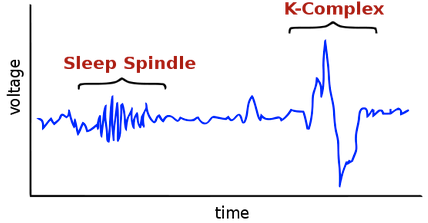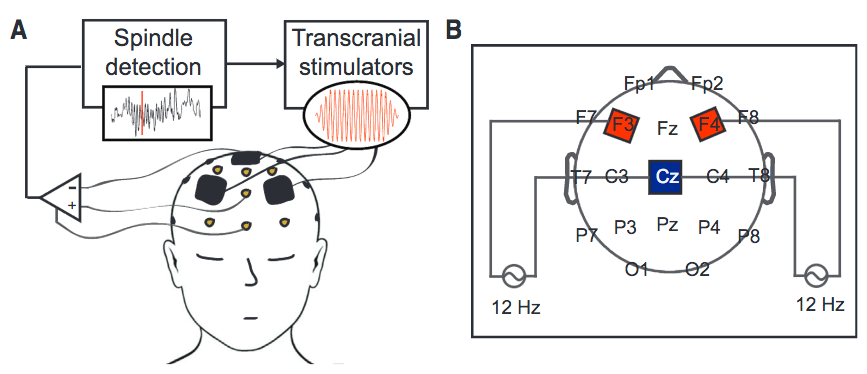Electric brain stimulation during sleep found to enhance motor memory consolidation
July 29, 2016
UNC Health Care | UNC Science Short: Sleep Spindles
University of North Carolina (UNC) School of Medicine scientists report using transcranial alternating current stimulation (tACS) to enhance memory during sleep, laying the groundwork for a new treatment paradigm for neurological and psychiatric disorders.
The findings, published in the journal Current Biology, offer a non-invasive method to potentially help millions of people with conditions such as autism, Alzheimer’s disease, schizophrenia, and major depressive disorder.
Do sleep spindles cause memory consolidation? The experiment.
For years, researchers have recorded electrical brain activity that oscillates or alternates during sleep on an electroencephalogram (EEG) as waves called sleep spindles. And scientists have suspected their involvement in cataloging and storing memories as we sleep.

Sleep spindle and associated K-Complex (credit: Neocadre/public domain)
“But we didn’t know if sleep spindles enable or even cause memories to be stored and consolidated,” said senior author UNC neuroscientist Flavio Frohlich, PhD, assistant professor of psychiatry and member of the UNC Neuroscience Center. “They could’ve been merely byproducts of other brain processes that enabled what we learn to be stored as a memory. But our study shows that, indeed, the spindles are crucial for the process of creating memories we need for everyday life. And we can target them to enhance memory.”

Feedback-Controlled Spindle tACS (A) Graphical representation of real-time spindle detection and feedback-controlled transcranial current stimulation. (B) Schematic of tACS current source and stimulation electrode configuration; stimulation electrode placement according to International 10-20 locations. (credit: Caroline Lustenberger et al./Current Biology)
During Frohlich’s study, 16 male participants underwent a screening night of sleep before completing two nights of sleep for the study.
Before going to sleep each night, all participants performed two common memory exercises — associative word-pairing tests and motor sequence tapping tasks, which involved repeatedly finger-tapping a specific sequence. During both study nights, each participant had electrodes placed at specific spots on their scalps. During sleep one of the nights, each person received tACS — an alternating current of weak electricity synchronized with the brain’s natural sleep spindles. During sleep the other night, each person received sham stimulation as placebo.
Direct causal link
Each morning, researchers had participants perform the same standard memory tests. Frohlich’s team found no improvement in test scores for associative word-pairing but a significant improvement in the motor tasks when comparing the results between the stimulation and placebo night.
“This demonstrated a direct causal link between the electric activity pattern of sleep spindles and the process of motor memory consolidation.” Frohlich said.
This marks the first time a research group has reported selectively targeting sleep spindles without also increasing other natural electrical brain activity during sleep. This has never been accomplished with tDCS* (transcranial direct current stimulation), the much more popular cousin of tACS in which a constant stream of weak electrical current is applied to the scalp (see Neuroscience researchers caution public about hidden risks of self-administered brain stimulation*).
“We’re excited about this because we know sleep spindles, along with memory formation, are impaired in a number of disorders, such as schizophrenia and Alzheimer’s,” said Caroline Lustenberger, PhD, first author and postdoctoral fellow in the Frohlich lab. “We hope that targeting these sleep spindles could be a new type of treatment for memory impairment and cognitive deficits.”
The challenging research ahead
Frohlich said the next step is to try the same type of non-invasive brain stimulation in patients that have known deficits in these spindle activity patterns.
Based on the Current Biology paper, it’s clear the team is just getting started, with a lot of interesting possibilities to explore. For example, they note that “it is still unclear which specific cortical regions might be involved in sleep-dependent memory consolidation.”
It’s a sort of jungle in there, one with unknown species. The researchers say they may target posterior brain regions using faster frequencies (e.g., 15 Hz tACS) to optimally benefit motor memory consolidation, for example, and that maybe they should try synchronization of frontal oscillatory activity. And they want to find out if spindles synchronized across cortical regions are “essential for memory consolidation to occur” or are only spindles localized to brain regions necessary for performing the task?
Future studies will also be needed to investigate more complex ‘‘real-life’’ motor tasks that benefit from sleep and to relate those findings to sleep spindles, they add. “Future studies are also needed to further find optimized stimulation parameters by means of ideal stimulation location (centro-parietal instead of frontal) and (spindle) frequency applied.”
And when it comes to developing neuro-therapeutics, things will get even wilder. Will anomalous spindle patterns need to be reconstructed and reinforced, or will whole new customized patterns be needed? And if so, would this be some kind of reconstruction of a person’s memory (at least, their motor memory, for starters)? and what about dealing with circadian desynchronization and its possible disruptive effects on spindle patterns? And does it makes sense to look at phase patterns, in addition to frequency?
And perhaps most interesting to Kurzweilians, could the ability to improve spindle patterns, using machine learning, lead one day to cyborg minds and merged human-machine superintelligence?
KurzweilAI will be closely following this fascinating research.
The study was funded by the National Institutes of Health, UNC Department of Psychiatry, UNC School of Medicine, and Swiss National Science Foundation.
* We asked Frohlich to comment on possible risks similar to those reported with tDCS. “So far, tACS used in laboratory studies (i.e., in a well-controlled environment) has been very safe and we have never experienced serious side effects in any of our tACS studies,” he said. “However, unregulated DIY use of tACS could indeed theoretically carry risks, albeit we do not know at this point.”
Abstract of Feedback-Controlled Transcranial Alternating Current Stimulation Reveals a Functional Role of Sleep Spindles in Motor Memory Consolidation
Transient episodes of brain oscillations are a common feature of both the waking and the sleeping brain. Sleep spindles represent a prominent example of a poorly understood transient brain oscillation that is impaired in disorders such as Alzheimer’s disease and schizophrenia. However, the causal role of these bouts of thalamo-cortical oscillations remains unknown. Demonstrating a functional role of sleep spindles in cognitive processes has, so far, been hindered by the lack of a tool to target transient brain oscillations in real time. Here, we show, for the first time, selective enhancement of sleep spindles with non-invasive brain stimulation in humans. We developed a system that detects sleep spindles in real time and applies oscillatory stimulation. Our stimulation selectively enhanced spindle activity as determined by increased sigma activity after transcranial alternating current stimulation (tACS) application. This targeted modulation caused significant enhancement of motor memory consolidation that correlated with the stimulation-induced change in fast spindle activity. Strikingly, we found a similar correlation between motor memory and spindle characteristics during the sham night for the same spindle frequencies and electrode locations. Therefore, our results directly demonstrate a functional relationship between oscillatory spindle activity and cognition.